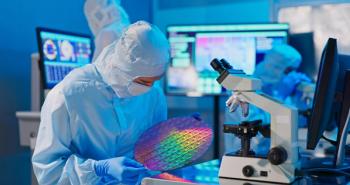
- Spectroscopy-06-01-2020
- Volume 35
- Issue 6
Nanoparticle-Assisted Analytical Strategies: Pushing the Limits of ICP-MS for Ultrasensitive Detection of Clinical Biomarkers
In celebration of Spectroscopy’s 35th Anniversary, leading experts discuss important issues and challenges in analytical spectroscopy.
Clearly, the awesome success of medical science in the development of personalized medicine has occurred because of many achievement such as the discovery, characterization, identification and quantification of novel biomarkers for improved patient care. Advances in mass spectrometry (MS) technology along with the high-resolution liquid-phase biomolecule separations, combined with the novel bioinformatics tools for large-scale data analysis, have been essential in this progress. At present, one of the major goals in developing clinically effective novel bioanalytical methods for the quantification of disease biomarkers is achieving high sensitivity, something of major importance for early alarm diagnosis and patient survival.
In this context, the bioanalytical community has made tremendous advances to satisfy the demand for reliable, cost-effective, robust, and powerful detection and monitoring strategies for disease biomarkers based on MS-technology. Recent advances in liquid chromatography coupled on-line to tandem mass spectrometry detection techniques for clinical biomarker discovery and detection have offered much hope for superior patient care, particularly for cancer diagnosis and treatment (1). However, the complexity, variation, and dynamic range of the biomolecules present in biological samples, along with the extremely low concentration levels that often need to be quantified, are among the major obstacles to using these methods to accurately quantify the biomarker levels. Additionally, molecular MS techniques, which are the most widely used in proteomic studies, use soft ionization sources to preserve molecular information, but these ion sources are not inherently quantitative. In molecular MS, the ion signal intensity is strongly affected not only by the molecular structure of the target biomolecule but also by the sample matrix and solvents used.
As an alternative, more than a decade ago, inductively coupled plasma–mass spectrometry (ICP-MS) was established as a quantitative tool in proteomics (and in biomarkers quantification), complementary to soft-ionization MS techniques. ICP-MS offers detection limits in the attomolar range, regardless of the molecular environment of the target element, with a broad linear dynamic range of several orders of magnitude, and simultaneous multi-isotopic analysis is routinely possible. Sensitivity, which is of great importance in bioanalysis, is affected very little in ICP-MS by the sample matrix or the chromatographic mobile phase. These advantages explain the key role that ICP-MS currently plays in biomarker quantification, via detection of an elemental label linked to the biomolecule of interest. For that purpose, a commonly used strategy is biomarker recognition with appropriate antibodies tagged with an ICP-MS–detectable element. Additionally, combining differentially elemental-labeled antibodies with ICP-MS detection could allow the design of multiplexed biomarker analytical methods. These special features of modern ICP-MS makes it possible to envisage the development of myriad possible biomedical applications of the technique and guarantees a bright future for this tool in biomarker quantification. In fact, a large variety of ICP-MS-based strategies for biomarker quantification have been already developed over the past two decades (2). Moreover, novel ICP-MS/MS instruments could play a critical role in the future of the use of ICP-MS for proteomics and biomarker quantification. The high selectivity offered by the MS/MS configuration reduced significantly chemical noise and background, allowing virtually interference-free and highly sensitive detection of some non-metal atoms naturally present in biomolecules, such as P and S, which can be used as endogenous elemental tags for the quantification of biomolecules by ICP-MS.
Biomarkers are typically present at ultralow concentration levels during the early stages of disease progression. Therefore, development of highly sensitive quantification tools is a must for clinical decision-making, allowing not only prompt clinical diagnosis but also making it possible to efficiency evaluate new therapies and to assess the prognosis of disease. The achievement of ultrahigh sensitivity requires the development of innovative approaches consisting of the use of different amplification platforms and amplification processes. In this vein, nanotechnology, in combination with elemental mass spectrometry, is today a powerful strategy offering unique opportunities for creating ultrasensitive bioassays.
A simple approach to introduce a high number of ICP-MS–detectable elements per biomarker, thus obtaining an amplified analytical signal, consists of using metal-containing nanoparticles (NPs) as biomarker antibody labels. Of course, such nanoparticle-tagged antibody approaches are more laborious and time-consuming than direct heteroatom-tag proteomics strategies and, what is worse, they may change protein properties (for example, possible modification of selected antibody recognition capabilities). However, inorganic nanoparticles contain a high number of ICP-MS–detectable atoms ranging from hundred to tens of thousands of atoms in each nanoparticle. Thus, strong signal amplification could be achieved by detecting the metal atoms labeled on one target obtaining very low LODs (3,4). Moreover, it is possible to use different inorganic nanoparticles, containing different elements, for labeling different antibodies, enabling multiplexed analysis of many biomarkers in a clinical sample with very high sensitivity and selectivity.
Unfortunately, sometimes detection limits achieved through inorganic nanoparticle-tagged immunoassays followed by ICP-MS detection are still not good enough to address the detection of disease biomarkers at the extremely low levels present in clinical samples during the early stages of disease, requiring the development of new signal amplification techniques for ultrasensitive detection. For such cases where ultrahigh sensitivity is required, novel innovative approaches have been recently reported, based on different amplification processes. One possibility to improve the sensitivity of ICP-MS detection could be the use of larger inorganic particles (microparticles). However, such an approach is not feasible because when larger particles are used the number of antibodies per inorganic particle increases, and as a result the signal-per-molecule is lower.
A drastic amplification of the ICP-MS signal is possible by resorting to a controlled immuno nanoparticle-gold amplification (5). Here ICP-MS signal amplification was achieved for prostate specific antigen (PSA) quantification by the precipitation of gold ions on the surface of Mn-doped ZnS quantum dots used as tags of a PSA antibody. The nanoparticle tags act as catalytic seeds to favor reduction of gold ions to metallic gold that is deposited on the surface of the nanoparticles (NP size amplification) after the immunoassay and before the tag detection. Much bigger nanoparticles are thus obtained and hence much better sensitivity with ICP-MS detection can be achieved (detection limits below fg/mL levels of the PSA biomarker were reported). In contrast with direct use of big particles (microparticles), this approach does not affect the recognition capabilities of antibodies, because size amplification is carried out once inmunorecognition has taken place. In addition, the method showed a very wide dynamic range exceeding eight orders of magnitude, which means that the method could be applied to the determination of biomarkers at many different concentration levels.
Another approach for improvement of ICP-MS sensitivity is nanoparticle analysis by single particle ICP-MS (spICP-MS). In spICP-MS, time-resolved transient signals induced by the flash of ions arising from the ionization of the inorganic nanoparticle when entering the plasma can reflect the concentrations of the NPs. Thus, sp-ICP-MS allows quantification of nanoparticle-tagged immunocomplexes by measuring the frequency of ion transient signals. Based on this principle, single nanoparticle analysis offers great potential for the development of extremely sensitive bioassays without the need for any signal amplification (6).
From this very brief overview, it can be concluded that the synergic combination of the power of ICP-MS detection with the selectivity of nanoparticle-tagged antibodies currently provides an outstanding tool to face the challenge of robust quantification of disease biomarkers with extremely high sensitivity. Looking ahead, it is clear that the design and implementation of novel amplification strategies, using inorganic nanoparticles, in combination with ICP-MS detection, will result in bioanalytical methods capable of addressing the problem of the detection of biomarkers at extremely low concentration levels, constituting an indispensable tool in clinical chemistry.
Finally, I would like to congratulate the Spectroscopy team in this celebration of the 35th year of publishing! Through the hard work and dedication of its editorial board, journal staff, and all contributors and sponsors the journal has become a leading publisher of contributions dealing with spectroscopic techniques and their applications in life sciences, environmental analysis, technology, industry, and academia. I am pleased and honored to participate in this special issue and I am confident that the next 35 years will witness the further growth of Spectroscopy and of its importance in the spectroscopy community.
References
- K.L. Simpson, A.D. Whetton, and C. Dive, J. Chromatogr. B 877, 1240–1249 (2009).
- L. Cid-Barrio, F. Calderon-Celis, P. Abasolo-Linares, M.L. Fernandez-Sanchez, J.M. Costa-Fernandez, J. Ruiz Encinar, and A. Sanz-Medel, Trends Anal. Chem. 104, 148–159 (2018).
- R. Liu, P. Wu, L. Yang, X. Hou, and Y. Lv, Mass Spec Rev. 33, 373–393 (2014).
- Z. Liu, X. Li, G. Xiao, B. Chen, M. He, and B. Hu, Trends Anal. Chem. 93, 78–101 (2017).
- M. Garcia-Cortes, J. Ruiz Encinar, J.M. Costa-Fernandez, and A. Sanz-Medel, Biosens. Bioelectron. 85, 128–134 (2016).
- J. Hu, D. Deng, R. Liu, and Y. Lv, J. Anal. At. Spectrom. 33, 57–67 (2018).
Jose M. Costa-Fernandez is a Full Professor of Analytical Chemistry in the Department of Physical and Analytical Chemistry at the University of Oviedo, in Oviedo, Spain. Direct correspondence to
Articles in this issue
over 5 years ago
Vol 35 No 6 Spectroscopy June 2020 Regular Issue PDFover 5 years ago
Celebrating 35 Years of Spectroscopyover 5 years ago
Handheld Near-Infrared Spectrometers: Reality and Empty Promisesover 5 years ago
One Real Challenge That Still Remains in Applied ChemometricsNewsletter
Get essential updates on the latest spectroscopy technologies, regulatory standards, and best practices—subscribe today to Spectroscopy.





